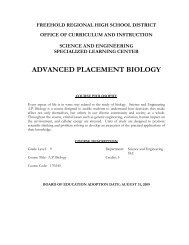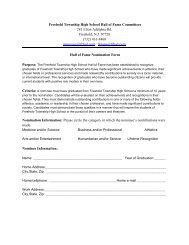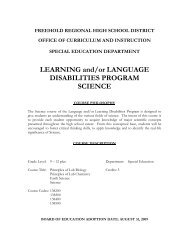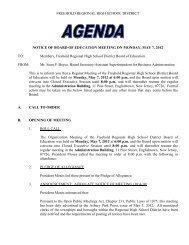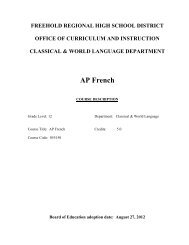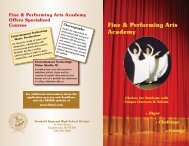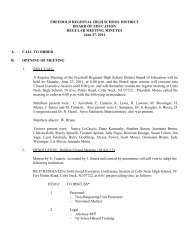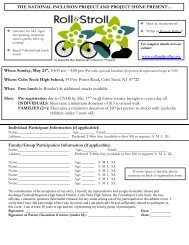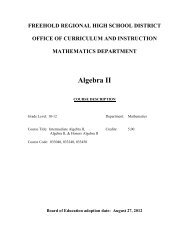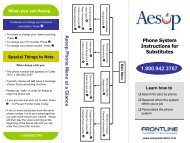PROBABILITY & STATISTICS - Freehold Regional High School District
PROBABILITY & STATISTICS - Freehold Regional High School District
PROBABILITY & STATISTICS - Freehold Regional High School District
You also want an ePaper? Increase the reach of your titles
YUMPU automatically turns print PDFs into web optimized ePapers that Google loves.
<strong>Freehold</strong> <strong>Regional</strong> <strong>High</strong> <strong>School</strong> <strong>District</strong>Probability & StatisticsUnit #4: ProbabilityEnduring Understanding: Probability describes the likelihood an event will occur.Essential Questions: How is probability used in everyday life?How does the study of probability integrate itself into the study of statistics?Unit Goals: Students will examine the role of probability in everyday life.Students will utilize probability to determine the likelihood of outcomes in myriad situations.Duration of Unit: 5 weeksNJCCCS: 4.4 B 1-6; C 1-4InstructionalGuiding / Topical Questions Content, Themes, Concepts, and Skills Resources andHow does one define probability?How do corporations and similar entitiesuse probability to make decisions?Why is it necessary to determine if twoevents are independent when calculatingprobabilities?What is the difference betweenpermutations and combinations?What is the difference between a discreteand a continuous variable?What is a probability distribution?Display the scale from 0 to 1 and define its relationto probability.Define the Law of Large Numbers and itsapplication to the insurance industry, casinos, andsimilar industries.Define compound events and explain replacementversus non-replacement.Explain the importance of determining whether ornot order is important.Define discrete and continuous variables.Establish how discrete and continuous variables areapplied to a probability distribution.MaterialsCurrent textbook andresource bindersInternetMagazinesNewspapersVideosGraphing CalculatorsTeachingStrategiesLecture and classdiscussionComplete thechapter study guidesStudentinvestigationactivitiesAssessment StrategiesWritten tests and quizzesWorksheetsProject assessmentsNotebook assessmentsResponses to discussionquestionsJournal assessmentsStudent response systemsfor immediate feedbackWhat is a binomial probabilitydistribution?How does a geometric probabilitydistribution differ from a binomialdistribution?Establish the conditions necessary for a probabilitydistribution to be considered binomial.Show a geometric probability distribution builds on abinomial distribution by dealing with the occurrenceof the first success.Suggestions on how to differentiate in this unit:• Students will work individually, engage in cooperative learning, and utilize discovery learning on certain activities.• Through the use of lectures, the internet, and interactive whiteboards, students will be exposed to various teaching methods to appeal to visual, auditory, andkinesthetic learners.• Students will be given copies of data sets and other important notes.• Manipulatives such as dice and playing cards can be used to illustrate the fundamental concepts of probability.11



